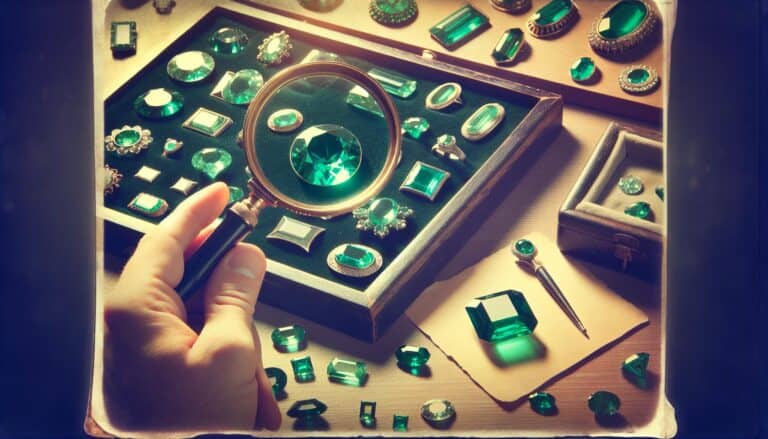Discovering the secrets of actinolite starts with knowing what to look for.
This fascinating mineral, part of the amphibole group, has unique features that set it apart. You’ll often find it in metamorphic rocks, but recognizing it requires a keen eye.
You’re about to learn the key characteristics that make actinolite stand out. From its distinct color to its crystal form, we’ll guide you through the simple steps to identify this mineral.
Whether you’re a budding geologist or simply a rock enthusiast, you’ll soon be spotting actinolite like a pro.
To identify actinolite, look for its dark green to gray colors and long, needle-like crystals. Conduct a streak test for a white streak. Actinolite is non-magnetic, with a Mohs hardness of 5.5-6, and displays birefringence. It’s typically translucent to opaque and shows double refraction, with a refractive index of 1.613-1.628.
How to Identify actinolite Through Testing
When you’re faced with a potential actinolite specimen, a series of tests can confirm your suspicion. Each test explained below will bring you closer to a definitive identification.
Visual Inspection
Start your identification process with a Visual Inspection. Look for the signature dark green to gray colors and the long, needle-like crystal formations. Actinolite’s luster should be vitreous to dull, and its formations can be either fibrous or dense. These initial clues are telling, but you’ll need more evidence to confirm actinolite.
The Streak Test
For the streak test, rub the mineral across an unglazed porcelain tile. Actinolite typically leaves a white streak, which can distinguish it from similar minerals.
Magnet Test
Actinolite doesn’t usually exhibit magnetic properties. If your specimen is magnetic, you’re likely dealing with a different amphibole mineral.
Hardness Test
Conduct a hardness test using Mohs scale. Actinolite has a hardness rating of 5.5 to 6, so it should be able to scratch glass and be scratched by a steel file.
Birefringence Test
Under a petrographic microscope, actinolite displays birefringence, where you’ll see two distinct images of a single object. This optical phenomenon is due to the mineral’s internal crystal structure.
Checking The Diaphaneity
Examine the diaphaneity, or the mineral’s transparency. Actinolite ranges from transparent to opaque. This test helps in distinguishing it from other similar minerals.
Single or Double Refraction
Actinolite exhibits double refraction, where light splits into two rays as it passes through the crystal. You can observe this by viewing a clear text page through the crystal; the text should appear doubled.
Refractive Index Test
Utilizing specialized equipment, measure the refractive index. Actinolite has a refractive index that typically falls between 1.613 – 1.628. These values are indicative of actinolite’s unique optical properties.
Finding The Specific Gravity
Analyze the specific gravity, where actinolite has a characteristic density of about 3.0 – 3.5 g/cm³. You’ll often need a lab setting to perform this test accurately.
Identifying Actinolites in the Field
When you’re in the field, recognize actinolite by its common occurrence within metamorphic rocks like schist and marble. It’s commonly associated with minerals like garnet and quartz, occurring as long prismatic crystals or bladed aggregates.
Recognizing Potential Actinolite Rocks
Potential actinolite-containing rocks often have a slaty or schistose texture. They can also be part of a greenschist facies, a specific set of metamorphic conditions conducive to actinolite formation. Look for the fibrous or radiating needle-like texture as an immediate indicator of actinolite presence.
Physical Characteristics of actinolites

When you’re determining whether a given mineral is actinolite, paying attention to physical characteristics is key. Actinolite has distinct features that differentiate it from other minerals. One of the most recognizable traits is color. Actinolite typically exhibits a range from light to dark green, but it can also occur in white, gray, or even black variations.
Crystal form is another critical attribute. Actinolite usually forms in elongated, bladed crystals, or in fibrous aggregates. These could be spread out or compact, contributing to its identifiable appearance. By observing the crystal system, you’ll notice actinolites generally belong to the monoclinic class. Crystals can be prismatic with striations running lengthwise, adding to their uniqueness.
Luster adds to actinolite’s character, often described as vitreous to silky, especially when it occurs in its fibrous form which is known as byssolite. In terms of transparency, actinolite may be translucent or opaque, influenced by impurities and the presence of other minerals.
Closely tied to color, the pleochroism of actinolite can be quite pronounced. Under polarized light, it exhibits varying colors, an indication of its optically active nature.
The hardness of actinolite, based on the Mohs scale, falls between 5 and 6, making it relatively hard. It’s tougher than gypsum but can be scratched by a knife or steel file, providing insight into its composition and strength.
Lastly, actinolite’s cleavage is perfect in two directions at 56 and 124 degrees, which is another diagnostic feature to help you identify it with certainty.
How Are actinolite Formed?
Actinolite forms under specific geological conditions that you might find fascinating. These amphibole minerals are typically found in metamorphic rocks, which are rocks that have been transformed by intense heat and pressure over time. Actinolite’s formation is closely tied to the metamorphism of low-grade minerals, especially those rich in iron and magnesium.
The process starts deep beneath the Earth’s surface where tectonic activities drive the transformations. When precursor materials like igneous rocks or sediments undergo metamorphosis, they can change both in texture and chemical composition. The conditions for actinolite to form require a combination of high pressure and relatively low temperature, such as those found in subduction zones or regions with a high geothermal gradient.
A key factor in actinolite’s formation is the presence of calcium and iron. When these elements meet the right conditions, they bond with silica and other trace elements to create the elongated, fibrous crystals that define the mineral. Locations where volcanic activity has occurred are prime spots where actinolite might be found due to the abundance of the necessary components and suitable environmental conditions.
As actinolite grows, it often forms intergrown masses within its host rock, such as schist or marble, leading to its fibrous or bladed crystal habit. While it’s rarely found in igneous rocks, actinolite can occur alongside other metamorphic minerals, often sharing similar formation histories and environments.
Preparation for actinolite Hunting
When venturing out to locate actinolite, being well-prepared is crucial. You’ll want to equip yourself with the right tools and prioritize your safety while engaging in mineral collection. Make sure you have everything you need before heading out on your actinolite hunting expedition.
Gathering the Right Tools
To enhance your chances of finding actinolite, you need to gather a few specific tools:
- Geologist hammer: This is essential for breaking rocks and extracting specimens.
- Hand lens or magnifying glass: Helps in closely examining potential finds.
- Sturdy gloves: Protect your hands during the digging and handling process.
- Safety goggles: Shield your eyes from debris when chipping away at rocks.
- Map and GPS device: Navigate to areas where metamorphic rocks are prevalent.
- Field guide: Assists in identifying actinolite and other minerals on-site.
Remember that having the right equipment not only aids in correctly identifying actinolite but also enhances the overall hunting experience.
Safety Considerations
While the hunt for actinolite can be exciting, your safety should always come first. Pay attention to these guidelines to ensure a safe searching adventure:
- Wear protective gear: This includes long sleeves, pants to avoid scrapes, and sturdy boots for proper footing.
- Inform someone: Always let a friend or family member know where you’ll be and when you expect to return.
- Be aware of your surroundings: Watch for hazards like falling rocks, wildlife, and unstable ground.
- Stay hydrated and energized: Carry enough water and snacks, especially when exploring remote locations.
- Respect the environment: Follow the leave-no-trace principles and avoid disturbing local ecosystems.
Equipped with the proper tools and safety precautions, you’re now ready to embark on your quest for actinolite, experiencing the thrill of discovery while minimizing risks. Remember to always verify the legality of collecting minerals in any area you explore.
Handling and Care of Found actinolites

Once you’ve successfully identified and collected actinolite specimens, proper handling and care become crucial to preserve their natural beauty and scientific value. By following the best practices for cleaning and storing your actinolites, you’ll ensure that they remain in pristine condition for years to come.
Cleaning and Storing Actinolites
Cleaning your actinolite specimens starts with a gentle approach. Use a soft brush to remove surface dirt. For more persistent grime, lukewarm water and a mild soap can be used. Rinse your specimens thoroughly to prevent soap residue, which can dull the actinolite’s luster. It’s essential to avoid using harsh chemicals or abrasive cleaning tools, as these can damage the mineral’s surface.
When your actinolites are clean and dry, storing them properly is the next step. Here are some tips to keep in mind:
- Wrap each specimen individually in tissue paper or bubble wrap to prevent scratching.
- Choose a storage box that’s sturdy and compartmentalized, which can provide both protection and organized display.
- Keep your specimens in a cool, dry place to prevent any potential damage from humidity.
- Label each actinolite with details like location found, date, and characteristics. This not only adds to your collection’s informational value but also helps in tracking your specimens.
Remember, each actinolite is unique and may require specific care. Always tailor your cleaning and storing techniques to the individual needs of your mineral specimens. With these best practices, your actinolite collection will remain as captivating and educational as the day you found them.
Conclusion: Confirming Actinolite Real
You’ve now got the know-how to identify actinolite and ensure that your specimens remain in pristine condition.
Remember to gently clean your finds with a soft brush and mild soap and steer clear of any harsh chemicals that could damage them. Storing your actinolite correctly is just as crucial; wrap each piece carefully and keep them in a secure, dry place. Don’t forget to label each specimen to track your collection’s history.
With these tips, you’ll maintain the value and allure of your actinolite treasures for years to come.


![Louisiana Rockhounding Sites in [year]: Best Spots & Treasures](https://observationhobbies.com/wp-content/uploads/2024/01/ZdocqQJBdU4beXX3hNxPc-768x439.jpg)




![Virginia Rockhounding Sites in [year]: Guide & Finds](https://observationhobbies.com/wp-content/uploads/2024/01/GLmeOzdUxOYuYKnhLJv6g-768x439.jpg)